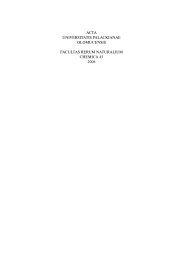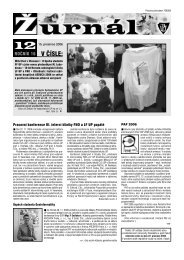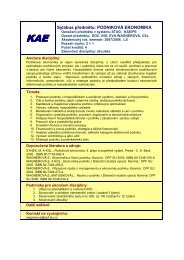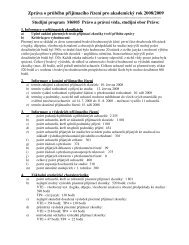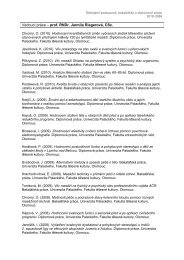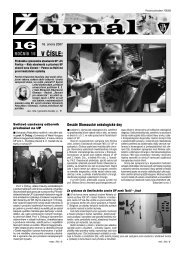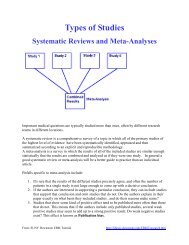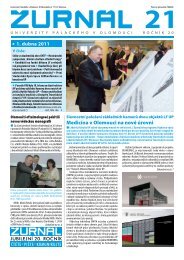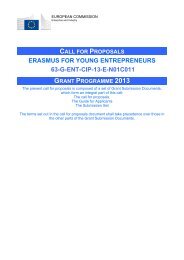ACTA UNIVERSITATIS PALACKIANAE OLOMUCENSIS GYMNICA ...
ACTA UNIVERSITATIS PALACKIANAE OLOMUCENSIS GYMNICA ...
ACTA UNIVERSITATIS PALACKIANAE OLOMUCENSIS GYMNICA ...
- No tags were found...
You also want an ePaper? Increase the reach of your titles
YUMPU automatically turns print PDFs into web optimized ePapers that Google loves.
40 Acta Univ. Palacki. Olomuc., Gymn. 2004, vol. 34, no. 2The push-up test manifested the muscle force of them.serratus anterior and rhombic muscles. Also hereonly 50% of the test exercise was performed properly.The mm. rhombodei draws the shoulder blade to thespine and pushes it a bit higher. The m. serratus anterioris involved in the protraction and anteversion ofthe shoulder blade. The m. trapezius is the auxiliarymuscle, which has a fixating and rotating effect on theshoulder blade.A conclusion from the above analysis: One reacts toexogenous and endogenous motor stimuli as in a system.Free climbing evokes evolutionarily old, ontogeneticallyearly motor coded models of reflexive motorics. This,together with the necessity of the application of stretchingbefore each climb, influences positively the motorsystem of athletes. In young judoists a certain tendencyis shown which is true also for other sports (Riegerová,2002). A unilateral load and neglect of compensationsat the very beginning of each training (although in thisparticular case, several sports clubs in three Moraviancities have been discussed) brings to light health problemsand is also a disincentive in achieving a successfulsports performance. This knowledge can further expandthe scope of exercises in health-oriented physical education.SUMMARYIn groups of athletes doing free climbing and judoand belonging to the Juvenis, Adultus and Maturus 1age groups, we conducted an analysis of muscle functionand motor stereotypes. On the average, climbershad achieved the VIIth level of difficulty (a good climbinglevel), the judoists had been doing judo at the 2 ndleague level.The low, almost zero, fi nding of shortening andsubstitutions in climbers gave us the idea of evocationof an evolutionarily old, early coded model of reflexivemotorics during climbing.Free climbing is the natural implementation ofrefl exive creeping and refl exive turning in space. Thegenetically coded locomotor model is, during the learning(training) process, specialized in its utilization insports.The incidence of muscular shortening is in directrelation to the performance of climbers, who have beendoing this sport from 1 to 9 years at the levels of difficultybetween the Vth and IXth (the shorter the climbingtime, the greater the extent of muscle shortening foran individual).The most problematic of the muscular region is thebilateral m. trapezius, where the shortening occurredin 33.3% and 22.2%. In 22% a shortening of the spinalerector in the lumbal area occurred. Substitute motorstereotypes were not found.With the group of judoists, a tendency was seenwhich is known even with other sports, confirming insufficientcompensation of both the unilateral trainingload and lifestyle. We noted the resulting high frequencyof shortening of the muscle group, securing motionsin the hip joint, knee fl exors and m. trapezius. Theestablished conditions of shortening correspond to thehigh percentage of substitution of hamstrings duringextension.This knowledge is worthy of further attention becauseit can help further expand the scope of exercisesin health-oriented physical education.REFERENCESJanda, V. (1996). Funkční svalový test. Praha: GradaPublishing.Přidalová, M. (2002). Stav a funkce nohy jako nezanedbatelnásoučást péče o podpůrně pohybový systém.In Š. Andělová (Ed.), XXX. ostravské dny dětí a dorostu(pp. 82–93). Ostrava: Repronis.Přidalová, M. (2000). Stav podpůrně pohybového systémuu selektovaných skupin dětí staršího školníhověku. In J. Riegerová (Ed.), Diagnostika pohybovéhosystému (pp. 144–148). Olomouc: VydavatelstvíUniverzity Palackého.Riegerová, J. et al. (1999). Základní somatometriea roz bor svalových funkcí u čtyř populačních skupinmužů a žen ve věku Maturus a Presenilis. Českáantropologie, 49, 28–31.Riegerová, J. (2002). Péče o stav svalového aparátua kloubní pohyblivosti – základní zásada primárníprevence poruch hybného systému. In Š. Andělová(Ed.), XXX. ostravské dny dětí a dorostu (pp. 63–67).Ostrava: Repronis.Tefelner, R. (1999). Trénink sportovního lezce. Brno:Datis.Vojta, V., & Peters, A. (1995). Vojtův princip. Prague:Grada Publishing.The study was supported by grant of Grant Agencyof Czech Republic No. 406/02/0146.HODNOCENÍ SVALOVÝCH FUNKCÍU SPORTOVCŮ ZABÝVAJÍCÍCH SE VOLNÝMLEZENÍM A JUDEM(Souhrn anglického textu)U souboru sportovců zabývajících se volným lezeníma judem ve věku Juvenis, Adultus a Maturus 1jsme provedli rozbor svalových funkcí a pohybovýchstereotypů. Sportovní lezci dosahovali v průměru VII.výkonnostního stupně (dobrá lezecká úroveň), judisté sejudem zabývali na úrovni 2. ligy. Nízký až nulový nález



